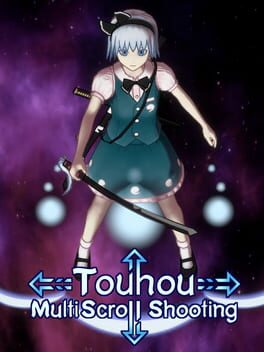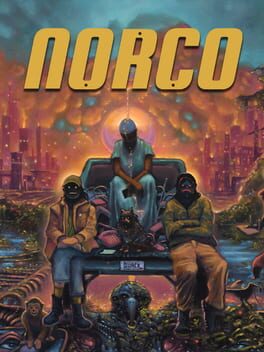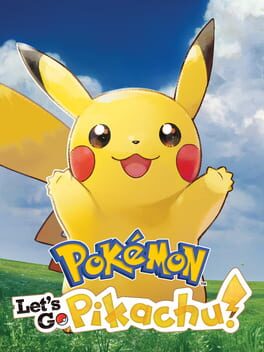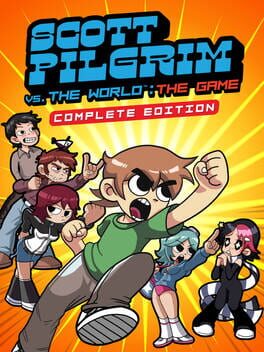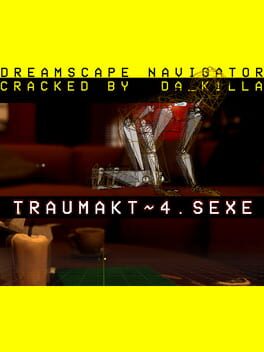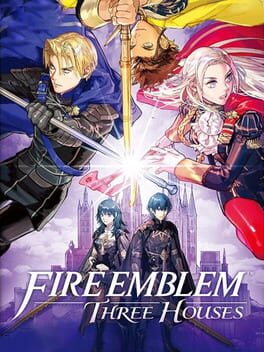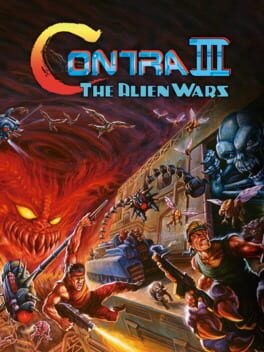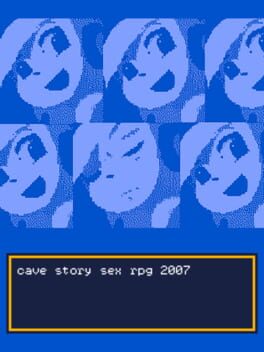Xator_Nova
2021
2020
@rubenmg, my friend Sagi and I talked about this game in-depth on this podcast (it's in Spanish though):
https://youtu.be/STdyVeo7-OE
https://youtu.be/STdyVeo7-OE
2022
I posted my thoughts on my blog: https://xatornova.blogspot.com/2020/05/pokemon-lets-go-fauna-in-patterns.html
I have already published my opinion on Pokémon (https://xatornova.blogspot.com/2018/06/pokemon-toy-adventure.html), and everything said there, good and bad, especially regarding the seventh generation, applies broadly to Pokémon Let's Go. However, the game differentiates itself from previous entries due to the capture system. Pokémon Let's Go abandons random combats and instead makes its wild creatures visible on the field, while removing combat in favor of allowing the player to face the creature and capture it directly. To give complexity to this mechanic, the game takes the capture system from Pokémon Go, where a precise throw becomes decisive. Moreover, the more precise is the throw, or better streak you have, the more experience you get, which is the game's incentive to master this system. Beyond trying to catch the attention of players that entered the series through Pokémon Go, the developers offer a different perspective to the essence of the franchise: To simulate the search and capture of creatures.
The game fails because its creatures aren't believable, and thus how we approach them isn't believable, either. When the monsters appear, they either stay still or move in patterns, waiting for the player to capture them without trying to attack you or flee, and then making a predictable animation to disrupt a throw or as a sign that they're escaping. This mechanization makes clear to the player that they're facing an artificial body, and the illusion of being in front of a living creature doesn't exist. We merely act according to preset patterns at our mercy whenever we want to catch them. Faking resistence without really challenging us. After all, it's just a game for kids, and director Junichi Masuda believes that more is too much for them.
This reduction of animal behavior to patterns is especially unacceptable after The Last Guardian became a milestone in the representation of a living being. On that game there's an inmense graphic detail in Trico, and the animal doesn't obey frequently to simulate the difficulties in comunication due to the absence of language, all in name of the creature being believable to our senses so that we don't perceive it as an extension of our will, but rather as a different body with its own presence. Those who have had a pet know that sentiment. As many orders as we give, it's difficult that our pet does what we want, because it's a living being with its own will, separate from ours.
It's admittedly an unfair comparison because The Last Guardian took ten years of development, and has only one creature instead of 151, but then we can observe another game with a similar intent: Pokémon Snap. In that game we control a photographer whose goal is to have the best photographs in the creatures' natural habitat. The game fails to convey the feeling of an habitat because the progress is preset on rails, and some Pokémon also follow the pitfall of having patterns. However, every creature acts different according to its species, and even some of them have different attitudes within the same species. Besides, many creatures are hidden behind coherent requirements to their species, and they reveal themselves due to our interaction with the environment. We throw bait to bring them closer, stink bombs to make them go away, or play the Poké Flute to wake them up. One of the most memorable examples is taking a Magikarp to a waterfall, because according to the Pokédex, Magikarps evolve into Gyarados when they climb one, and that's what happens in the game. Because of the active involvement with the scenario and its creatures, the game manages to convince the player that it isn't a fauna willing to serve you. In fact they ignore you, and if they went their own way and you didn't pay attention, bad luck.
The examples that I mentioned aren't an ideal of what Pokémon Let's Go should be, but they're a demonstration that even if its premise is interesting within the context of the series, the execution is the laziest possible. If it's genuinely because of being a children's game, I consider such condescendence insulting to the coming generation when it's precisely them for whom we should give our best.
I have already published my opinion on Pokémon (https://xatornova.blogspot.com/2018/06/pokemon-toy-adventure.html), and everything said there, good and bad, especially regarding the seventh generation, applies broadly to Pokémon Let's Go. However, the game differentiates itself from previous entries due to the capture system. Pokémon Let's Go abandons random combats and instead makes its wild creatures visible on the field, while removing combat in favor of allowing the player to face the creature and capture it directly. To give complexity to this mechanic, the game takes the capture system from Pokémon Go, where a precise throw becomes decisive. Moreover, the more precise is the throw, or better streak you have, the more experience you get, which is the game's incentive to master this system. Beyond trying to catch the attention of players that entered the series through Pokémon Go, the developers offer a different perspective to the essence of the franchise: To simulate the search and capture of creatures.
The game fails because its creatures aren't believable, and thus how we approach them isn't believable, either. When the monsters appear, they either stay still or move in patterns, waiting for the player to capture them without trying to attack you or flee, and then making a predictable animation to disrupt a throw or as a sign that they're escaping. This mechanization makes clear to the player that they're facing an artificial body, and the illusion of being in front of a living creature doesn't exist. We merely act according to preset patterns at our mercy whenever we want to catch them. Faking resistence without really challenging us. After all, it's just a game for kids, and director Junichi Masuda believes that more is too much for them.
This reduction of animal behavior to patterns is especially unacceptable after The Last Guardian became a milestone in the representation of a living being. On that game there's an inmense graphic detail in Trico, and the animal doesn't obey frequently to simulate the difficulties in comunication due to the absence of language, all in name of the creature being believable to our senses so that we don't perceive it as an extension of our will, but rather as a different body with its own presence. Those who have had a pet know that sentiment. As many orders as we give, it's difficult that our pet does what we want, because it's a living being with its own will, separate from ours.
It's admittedly an unfair comparison because The Last Guardian took ten years of development, and has only one creature instead of 151, but then we can observe another game with a similar intent: Pokémon Snap. In that game we control a photographer whose goal is to have the best photographs in the creatures' natural habitat. The game fails to convey the feeling of an habitat because the progress is preset on rails, and some Pokémon also follow the pitfall of having patterns. However, every creature acts different according to its species, and even some of them have different attitudes within the same species. Besides, many creatures are hidden behind coherent requirements to their species, and they reveal themselves due to our interaction with the environment. We throw bait to bring them closer, stink bombs to make them go away, or play the Poké Flute to wake them up. One of the most memorable examples is taking a Magikarp to a waterfall, because according to the Pokédex, Magikarps evolve into Gyarados when they climb one, and that's what happens in the game. Because of the active involvement with the scenario and its creatures, the game manages to convince the player that it isn't a fauna willing to serve you. In fact they ignore you, and if they went their own way and you didn't pay attention, bad luck.
The examples that I mentioned aren't an ideal of what Pokémon Let's Go should be, but they're a demonstration that even if its premise is interesting within the context of the series, the execution is the laziest possible. If it's genuinely because of being a children's game, I consider such condescendence insulting to the coming generation when it's precisely them for whom we should give our best.
2023
This review contains spoilers
idk if I got to the end, I played all three routes, the shmup section, and the computer screen appeared where
- I couldn't start the dream executable anymore
- I couldn't log off anymore
- the reboot options were "Mind Break" everywhere
rebooting from "Mind Break" restarts the game from the very beginning
if there's anything else lemme know
- I couldn't start the dream executable anymore
- I couldn't log off anymore
- the reboot options were "Mind Break" everywhere
rebooting from "Mind Break" restarts the game from the very beginning
if there's anything else lemme know
This review contains spoilers
I wrote about Three Houses in my blog: https://xatornova.blogspot.com/2020/05/three-houses-teachers-pet.html
In spite of the advertising claims from developers, Three Houses doesn't really resemble Genealogy of the Holy War. The drama between the protagonists in Three Houses, Edelgard, Dimitri and Claude, is different than Sigurd's, Quan's and Eldigan's in Genealogy. In Three Houses, the student representatives are barely friends. They're rather rivals, while in Genealogy, the trio is perceived from the moment they're introduced that they're very close friends. It isn't about moral or political dilemmas or perceiving different perspectives either. The game becomes actually worse being interpreted this way, since one isn't conscious of the implications of each faction when you're choosing a team, and it avoids having a political position to suggest opposite options as equally positive to the social conditions of its world, which is a coward measure to dress a story with vagueness to fake depth while avoiding alienating the audience. A purely commercial resource, in the worst case a toxic one, and the division that it provokes within Fire Emblem enthusiasts is proof of it.
In truth, Three Houses owes its development to two franchises: Langrisser, because of its medieval fantasy in strategy role-playing game format where narrative branches itself according to the player's decisions, and they face characters that would be your allies under other circumstances to accentuate the drama; and Persona due to the social simulation, school setting and the calendar with activities. By putting the player on the shoes of a teacher, Three Houses uses this structure to involve them with the students emotionally. One is responsible of their education, their motivations and the game allows to transfer them to your class if they belong to another one. When the player gets to the second half, the time that has been spent with them hurts when seeing young promises facing each other in the name of a political cause, and feeling remorse not just at them falling by your hands, but also at not having saved them in spite of having had the possibility, since the game deprives the player from this possibility by the second half. Three Houses's biggest accomplishment is thus exploring loss in the genre beyond permanent death or defeat, which potentially expands the magnitude of the conflict for the player more strongly than previous entries. However, the poor development of two main aspects undermines its communicative power: The characterization and the combat mechanics.
The issue with the characters is that they're generally preset archetypes from japanese animation. The flirtatious girl, the womanizer, the lazy guy, the timid girl that hides in her room, the religious chaste, the nerd, the dumb big guy with a good heart, the fangirl, the damaged boy that needs comfort, the antisocial guy with hidden depths, the exchange student that doesn't understand some concepts, etc. The game tries to justify these archetypes with backgrounds to try to give them depth, but the dialogues, the voices, the gestures and everything else accomodates to the archetype. What a person suggests from themselves through the subtlety of a gesture, the game leaves it explicitly and without interpretation, to the immediate understanding of the player, and thus they're not believable people, regardless of whether they're nice or not. That's an issue with a lot of fiction, but this game requires that you believe that there are people there, and if they're not convincing, the impact is destroyed.
The matter with the characters isn's just limited to our perception of the conflict, but also the perception of the bonds due to how servile is the presentation of the characters. The implausibility that was mentioned above contributes to this, but it's the mere fact that other characters can join you in spite of the political alignment, since they show diametrically opposite convictions in different narrative branches, and this turns their motivations into dubious and without any other explanation than they join you because they like you, you give them gifts that they like, or tell them what they want to hear. The clearest example is in Edelgard's path. You have the option of betraying her, and almost every student will follow your decision and comment a different political position according to your decision. This self-centered logic applies to different aspects of the game. Because it's you is that one of the factions wins or is the good side. Because it's you is that they join and admire you. You're the chosen one by Sothis, you have the Divine Pulse to undo actions and your impact is always positive. This issue has existed since the introduction of a self-insert avatar as an unit in battle since New Mystery of the Emblem, but it's a bigger issue here due to the goal of the game being the the player's involvement with the students on an emotional level. It doesn't allow for a genuine connection because the game portrays your bonds as a teacher like a vending machine for favors, when in truth it's more laborious to win over the trust of a student.
It's curious, too, that the game's servitude is reflected in the combat mechanics, since the monastery, which serves as refuge to prepare for battle, gives the player tools that are much more potent than the opponent's and they give room to unbeatable combinations, such as skills that make an unit attack first and perform critical hits from any distance continuously. The most notorious advantage is the extension of movement. Since the players can change their class freely, they can become flying units, undoubtedly the best class in the game, to ignore terrain and avoid obstacles that grounded units wouldn't be able to. Besides, the player has easy access to the Stride command, which increases the movement of many units in five spaces, and the game allows access to the Warp spell, which transports an adjacent unit to another point of the map. The game doesn't seem to be thought up with these three mechanics, since the player has an easy time inferring how to get to the boss in one turn on most maps, and because the main objective in them is to kill the boss, that turn is the only one even in the highest difficulty. That maps lack valuable incentives to prefer other approach doesn't help.
By itself, the presence of this dominant strategy is the sign of a negligent design due to how little the map composition, classes and abilities that aren't the most powerful ones end up mattering, but the anticlimax that's caused by finishing maps in one turn decreases the graveness of the conflict that Three Houses pretends to suggest. Japanese simulation role-playing games utilize the grid system as an abstraction of a battlefield since 1982 with The Dragon and Princess, and Fire Emblem contextualizes this in a medieval fantasy with the field being the place of a warfare conflict where anyone can die, and loss rears its head. Since it's the way to perceive the war directly, danger and map length are important to involve the player mentally by placing them amidst the conflict, and this is recognized by the series's creator by stating that what's important about difficulty is how it makes us feel by the end. With this in mind, when the player completes maps in one turn intuitively, the melodrama that surrounds this game isn't more than just lip service that doesn't correlate to our direct perception of the battle. The scope of the conflict becomes minuscule, and the map's presence doesn't evoke any sentiment. It's disappointing that it happens due to Intelligent Systems looking to resemble other Japanese role-playing games to catch their audience and make the player feel better about themselves.
The most pitiful thing is that these aspects pale in comparison to efforts from simulation role-playing games that preceded Three Houses many years ago. Mystery of the Emblem deprives mounted units in indoor maps, forcing the player to forego the movement advantage. Genealogy of the Holy War doesn't allow any step through the terrain to become imperceptible due to the mechanics that extend movement benefiting grounded units, which gives a strong impression of the scope of the conflict in spite of clearing maps in few turns. Langrisser 4 doesn't fall into having dubious motivations because the political convictions of its characters have to align to yours to be able to become a part of your team, which happens after many battles, and belonging to an alignment involves coherent actions with the world beyond picking from a menu. Berwick Saga also has an explorable base where resources are accumulated and the player can prepare for the next mission, yet it doesn't need to lose time with superfluous activities; and the characters that you recruit demand a monetary payment during each mission until the bond with your cause becomes strong through the player's action, creating thus a more intimate connection and giving more uniqueness to the characters due to the variety of requirements.
Three Houses is unfortunately more of a concept than execution because its promising premise is dampened by its characterization and counterproductive mechanics that are there as complacency. It feels like it doesn't matter to concentrate on the point of the game, but rather to accomodate to commercial standards, without any consideration for consistency or focus. It's a tendency that I observe in high-budget Japanese games of the last few years, even those that I like the most, and I consider it worrisome for the future of the series since it sets yet another precedent in having acceptance by compromising the communicative impact, and depriving the game from its potential.
SPOILERS
Potential that appears unexpectedly on an element to which we can relate: The cruel repercussion of the passing of time in our friendships. In one of the scenes, it is explained that Dimitri and Edelgard used to be very intimate friends many years ago, and even the first romantic feelings are insinuated, yet they were separated by political circumstances. In their last day together, Dimitri gifts Edelgard a dagger, which will serve her to open her path to her dreams. Years later, each one went through their lives, with very tragic events in them that shaped them, and later they become representatives of different political ideologies. Because of this they are barely friends when they see each other again, and they have changed a lot, to a point where they lead their nations in war against each other. Even if Edelgard preserved the dagger for years as a proof of her appreciation towards him, both of them accept in front of the other shortly before the final confrontation that they aren't the children that used to be friends anymore, and their differences are irreconcilable. It's the most moving part of the game because growing up and realizing that you have become distant from somebody hurts, even when you wish another opportunity. However, that the emphasis on the emotional side of the conflict between each other only exists in one of the narrative branches is a testament to the little importance that Intelligent Systems gives to these feelings by dilluting them among so much content and indulgence. It's a pity that it's a testament to them having changed, too.
In spite of the advertising claims from developers, Three Houses doesn't really resemble Genealogy of the Holy War. The drama between the protagonists in Three Houses, Edelgard, Dimitri and Claude, is different than Sigurd's, Quan's and Eldigan's in Genealogy. In Three Houses, the student representatives are barely friends. They're rather rivals, while in Genealogy, the trio is perceived from the moment they're introduced that they're very close friends. It isn't about moral or political dilemmas or perceiving different perspectives either. The game becomes actually worse being interpreted this way, since one isn't conscious of the implications of each faction when you're choosing a team, and it avoids having a political position to suggest opposite options as equally positive to the social conditions of its world, which is a coward measure to dress a story with vagueness to fake depth while avoiding alienating the audience. A purely commercial resource, in the worst case a toxic one, and the division that it provokes within Fire Emblem enthusiasts is proof of it.
In truth, Three Houses owes its development to two franchises: Langrisser, because of its medieval fantasy in strategy role-playing game format where narrative branches itself according to the player's decisions, and they face characters that would be your allies under other circumstances to accentuate the drama; and Persona due to the social simulation, school setting and the calendar with activities. By putting the player on the shoes of a teacher, Three Houses uses this structure to involve them with the students emotionally. One is responsible of their education, their motivations and the game allows to transfer them to your class if they belong to another one. When the player gets to the second half, the time that has been spent with them hurts when seeing young promises facing each other in the name of a political cause, and feeling remorse not just at them falling by your hands, but also at not having saved them in spite of having had the possibility, since the game deprives the player from this possibility by the second half. Three Houses's biggest accomplishment is thus exploring loss in the genre beyond permanent death or defeat, which potentially expands the magnitude of the conflict for the player more strongly than previous entries. However, the poor development of two main aspects undermines its communicative power: The characterization and the combat mechanics.
The issue with the characters is that they're generally preset archetypes from japanese animation. The flirtatious girl, the womanizer, the lazy guy, the timid girl that hides in her room, the religious chaste, the nerd, the dumb big guy with a good heart, the fangirl, the damaged boy that needs comfort, the antisocial guy with hidden depths, the exchange student that doesn't understand some concepts, etc. The game tries to justify these archetypes with backgrounds to try to give them depth, but the dialogues, the voices, the gestures and everything else accomodates to the archetype. What a person suggests from themselves through the subtlety of a gesture, the game leaves it explicitly and without interpretation, to the immediate understanding of the player, and thus they're not believable people, regardless of whether they're nice or not. That's an issue with a lot of fiction, but this game requires that you believe that there are people there, and if they're not convincing, the impact is destroyed.
The matter with the characters isn's just limited to our perception of the conflict, but also the perception of the bonds due to how servile is the presentation of the characters. The implausibility that was mentioned above contributes to this, but it's the mere fact that other characters can join you in spite of the political alignment, since they show diametrically opposite convictions in different narrative branches, and this turns their motivations into dubious and without any other explanation than they join you because they like you, you give them gifts that they like, or tell them what they want to hear. The clearest example is in Edelgard's path. You have the option of betraying her, and almost every student will follow your decision and comment a different political position according to your decision. This self-centered logic applies to different aspects of the game. Because it's you is that one of the factions wins or is the good side. Because it's you is that they join and admire you. You're the chosen one by Sothis, you have the Divine Pulse to undo actions and your impact is always positive. This issue has existed since the introduction of a self-insert avatar as an unit in battle since New Mystery of the Emblem, but it's a bigger issue here due to the goal of the game being the the player's involvement with the students on an emotional level. It doesn't allow for a genuine connection because the game portrays your bonds as a teacher like a vending machine for favors, when in truth it's more laborious to win over the trust of a student.
It's curious, too, that the game's servitude is reflected in the combat mechanics, since the monastery, which serves as refuge to prepare for battle, gives the player tools that are much more potent than the opponent's and they give room to unbeatable combinations, such as skills that make an unit attack first and perform critical hits from any distance continuously. The most notorious advantage is the extension of movement. Since the players can change their class freely, they can become flying units, undoubtedly the best class in the game, to ignore terrain and avoid obstacles that grounded units wouldn't be able to. Besides, the player has easy access to the Stride command, which increases the movement of many units in five spaces, and the game allows access to the Warp spell, which transports an adjacent unit to another point of the map. The game doesn't seem to be thought up with these three mechanics, since the player has an easy time inferring how to get to the boss in one turn on most maps, and because the main objective in them is to kill the boss, that turn is the only one even in the highest difficulty. That maps lack valuable incentives to prefer other approach doesn't help.
By itself, the presence of this dominant strategy is the sign of a negligent design due to how little the map composition, classes and abilities that aren't the most powerful ones end up mattering, but the anticlimax that's caused by finishing maps in one turn decreases the graveness of the conflict that Three Houses pretends to suggest. Japanese simulation role-playing games utilize the grid system as an abstraction of a battlefield since 1982 with The Dragon and Princess, and Fire Emblem contextualizes this in a medieval fantasy with the field being the place of a warfare conflict where anyone can die, and loss rears its head. Since it's the way to perceive the war directly, danger and map length are important to involve the player mentally by placing them amidst the conflict, and this is recognized by the series's creator by stating that what's important about difficulty is how it makes us feel by the end. With this in mind, when the player completes maps in one turn intuitively, the melodrama that surrounds this game isn't more than just lip service that doesn't correlate to our direct perception of the battle. The scope of the conflict becomes minuscule, and the map's presence doesn't evoke any sentiment. It's disappointing that it happens due to Intelligent Systems looking to resemble other Japanese role-playing games to catch their audience and make the player feel better about themselves.
The most pitiful thing is that these aspects pale in comparison to efforts from simulation role-playing games that preceded Three Houses many years ago. Mystery of the Emblem deprives mounted units in indoor maps, forcing the player to forego the movement advantage. Genealogy of the Holy War doesn't allow any step through the terrain to become imperceptible due to the mechanics that extend movement benefiting grounded units, which gives a strong impression of the scope of the conflict in spite of clearing maps in few turns. Langrisser 4 doesn't fall into having dubious motivations because the political convictions of its characters have to align to yours to be able to become a part of your team, which happens after many battles, and belonging to an alignment involves coherent actions with the world beyond picking from a menu. Berwick Saga also has an explorable base where resources are accumulated and the player can prepare for the next mission, yet it doesn't need to lose time with superfluous activities; and the characters that you recruit demand a monetary payment during each mission until the bond with your cause becomes strong through the player's action, creating thus a more intimate connection and giving more uniqueness to the characters due to the variety of requirements.
Three Houses is unfortunately more of a concept than execution because its promising premise is dampened by its characterization and counterproductive mechanics that are there as complacency. It feels like it doesn't matter to concentrate on the point of the game, but rather to accomodate to commercial standards, without any consideration for consistency or focus. It's a tendency that I observe in high-budget Japanese games of the last few years, even those that I like the most, and I consider it worrisome for the future of the series since it sets yet another precedent in having acceptance by compromising the communicative impact, and depriving the game from its potential.
SPOILERS
Potential that appears unexpectedly on an element to which we can relate: The cruel repercussion of the passing of time in our friendships. In one of the scenes, it is explained that Dimitri and Edelgard used to be very intimate friends many years ago, and even the first romantic feelings are insinuated, yet they were separated by political circumstances. In their last day together, Dimitri gifts Edelgard a dagger, which will serve her to open her path to her dreams. Years later, each one went through their lives, with very tragic events in them that shaped them, and later they become representatives of different political ideologies. Because of this they are barely friends when they see each other again, and they have changed a lot, to a point where they lead their nations in war against each other. Even if Edelgard preserved the dagger for years as a proof of her appreciation towards him, both of them accept in front of the other shortly before the final confrontation that they aren't the children that used to be friends anymore, and their differences are irreconcilable. It's the most moving part of the game because growing up and realizing that you have become distant from somebody hurts, even when you wish another opportunity. However, that the emphasis on the emotional side of the conflict between each other only exists in one of the narrative branches is a testament to the little importance that Intelligent Systems gives to these feelings by dilluting them among so much content and indulgence. It's a pity that it's a testament to them having changed, too.
Podcast en español del juego (con Erika Niwatori): https://youtu.be/T9cquyH_aqo
2018
Note: I played on the hardest difficulty setting.
I can see where Capcom was going with this. Play through the levels, and buy items in Dr. Light's shop with your hard earned bolts to help you prepare for each journey. There's a reason why Mega Man 11 features the longest levels in the franchise. The idea is to carefully consider what to invest on and what is more necessary for your journey, which should invite to a mental involvement with the game. It should be a huge cost to pay and you could lose it all in a game over.
The problem is that Capcom somehow didn't consider how this would repercute on the player's behavior. Because enemies respawn, and there's always a chance to find bolts after destroying any enemy, it's very easy for any player to just start farming for them, and the result is that the tension of what should a player invest in disappears, since they can just buy everything at the shop after some sessions of collecting materials. Nothing in the game stops you from doing so. It's like grinding in a JRPG. It makes the intended design fall apart. However, even if we disregard this exploit, Mega Man 11 shows serious design oversights in its intended game experience.
Allow me to illustrate this: An extra life costs 40 bolts (50 after some levels), and an extra energy tank costs 80 bolts (100 after some levels). An item that quadruples your defense costs 100. Each of the earliest levels gave me around 1000 bolts. In Tundra Man's stage, I got around 3000 there alone. After wondering why this happened, I looked up how many bolts I was receiving per drop, and they were 10 in the smallest drops, and 100 in the bigger ones approximately. If the game really intended to make the player feel that they're preparing for a journey, this generosity feels like a counterproductive measure, and instead is condescension to make the player not feel like they didn't accomplish anything and need to improve to overcome the challenges, like the original games expected from them.
All of this is important because it causes a snowball effect. Enemy damage is moderately high, but it doesn't matter much because you can heal with your energy tanks, or you can just die and try again, and trudge with brute force, instead of perceiving each level as a journey on its own right. Because you won't be using every resource you have bought, you will invest less and less in surviving, and more in those upgrades that make you even stronger. I had three Robot Masters left after I used everything I earned in Tundra Man's stage to get every upgrade I needed, and had capped pretty much everything. I never got a game over and was able to defeat every boss in my first serious attempt after the first stage.
This game feels like a project to save the Mega Man franchise in its 30th anniversary, but I don't think it captures the feeling of the original games. When I replayed Mega Man 1 a few years ago, even when I didn't find it as difficult as I did as a child anymore, I still had tension of losing my progress in a level. Everything I see here now is a game afraid of the series's past to fit in the landscape of modern gaming, which is probably more coward than being a nostalgic celebration.
I can see where Capcom was going with this. Play through the levels, and buy items in Dr. Light's shop with your hard earned bolts to help you prepare for each journey. There's a reason why Mega Man 11 features the longest levels in the franchise. The idea is to carefully consider what to invest on and what is more necessary for your journey, which should invite to a mental involvement with the game. It should be a huge cost to pay and you could lose it all in a game over.
The problem is that Capcom somehow didn't consider how this would repercute on the player's behavior. Because enemies respawn, and there's always a chance to find bolts after destroying any enemy, it's very easy for any player to just start farming for them, and the result is that the tension of what should a player invest in disappears, since they can just buy everything at the shop after some sessions of collecting materials. Nothing in the game stops you from doing so. It's like grinding in a JRPG. It makes the intended design fall apart. However, even if we disregard this exploit, Mega Man 11 shows serious design oversights in its intended game experience.
Allow me to illustrate this: An extra life costs 40 bolts (50 after some levels), and an extra energy tank costs 80 bolts (100 after some levels). An item that quadruples your defense costs 100. Each of the earliest levels gave me around 1000 bolts. In Tundra Man's stage, I got around 3000 there alone. After wondering why this happened, I looked up how many bolts I was receiving per drop, and they were 10 in the smallest drops, and 100 in the bigger ones approximately. If the game really intended to make the player feel that they're preparing for a journey, this generosity feels like a counterproductive measure, and instead is condescension to make the player not feel like they didn't accomplish anything and need to improve to overcome the challenges, like the original games expected from them.
All of this is important because it causes a snowball effect. Enemy damage is moderately high, but it doesn't matter much because you can heal with your energy tanks, or you can just die and try again, and trudge with brute force, instead of perceiving each level as a journey on its own right. Because you won't be using every resource you have bought, you will invest less and less in surviving, and more in those upgrades that make you even stronger. I had three Robot Masters left after I used everything I earned in Tundra Man's stage to get every upgrade I needed, and had capped pretty much everything. I never got a game over and was able to defeat every boss in my first serious attempt after the first stage.
This game feels like a project to save the Mega Man franchise in its 30th anniversary, but I don't think it captures the feeling of the original games. When I replayed Mega Man 1 a few years ago, even when I didn't find it as difficult as I did as a child anymore, I still had tension of losing my progress in a level. Everything I see here now is a game afraid of the series's past to fit in the landscape of modern gaming, which is probably more coward than being a nostalgic celebration.
The graphic and sound design is quality. It's weird to bring this up first, but the way that this is implemented in the game helps the B-movie atmosphere that it's aiming for. Like many sequels in the Super Famicom era, Contra III wants to impress with spectacularity, and in this franchise inspired in 80s action movies, it doesn't seem that unfitting on first glance.
The problem arises when it tries to become an spectacle in the gameplay as well, and relies in prepared action setpieces that they clearly don't have much experience on, which results in the opposite effect that are anticlimatic scenes. You just have to see boss fights as the example of this. Every boss seems more complicated than the Famicom games, but the truth is that they follow an established, predictable pattern that the player merely has to follow. The game switches to top down perspective, but the action doesn't compare to dedicated top down shooters like Ikari Warriors. These two are further undermined with the presence of more varied, stronger weaponry to make Contra III seem bigger than its predecessors. The game is clearly not prepared to it, and the result is that these setpieces fall in seconds. It's like if the game didn't feel confident on its own run and gun action, and tried desperately to make up for it in the name of variety.
The game remains good because 1) these action setpieces still remain competent, and the variety is wide enough that the game never stops surprising the player while the run and gun segments are solid, and 2) the fact that there's a huge difference in performance with and without powerups makes the player remain attentive to the game's action to avoid losing their power-ups.
Note: The Japanese version, Contra Spirits, for some reason has unlimited credits, turning the mind-exhausting shooter action to survive into just getting to the next check point. The best experience is the international version.
The problem arises when it tries to become an spectacle in the gameplay as well, and relies in prepared action setpieces that they clearly don't have much experience on, which results in the opposite effect that are anticlimatic scenes. You just have to see boss fights as the example of this. Every boss seems more complicated than the Famicom games, but the truth is that they follow an established, predictable pattern that the player merely has to follow. The game switches to top down perspective, but the action doesn't compare to dedicated top down shooters like Ikari Warriors. These two are further undermined with the presence of more varied, stronger weaponry to make Contra III seem bigger than its predecessors. The game is clearly not prepared to it, and the result is that these setpieces fall in seconds. It's like if the game didn't feel confident on its own run and gun action, and tried desperately to make up for it in the name of variety.
The game remains good because 1) these action setpieces still remain competent, and the variety is wide enough that the game never stops surprising the player while the run and gun segments are solid, and 2) the fact that there's a huge difference in performance with and without powerups makes the player remain attentive to the game's action to avoid losing their power-ups.
Note: The Japanese version, Contra Spirits, for some reason has unlimited credits, turning the mind-exhausting shooter action to survive into just getting to the next check point. The best experience is the international version.
After stepping out of the first area, you make your first steps onto Crocodile Island, and a landscape of lava unfolds. Bubbles sprout from the lake of fire, and rivers of magma fall from mountains in the background while David Wise's Hot Head Bop sounds in the background. You can hear everything happening around you.
I wouldn't fixate so much in the presentation but Rare did achieve something quite singular beyond realistic-looking scenery. It is a combination of both aesthetically inspired work and sound design that makes the levels have a breathing presence, almost a world-like feeling even, that still resonates to this day.
It's clearly where the efforts went though because once you pick the controller you remember you are playing yet another video game sequel. More to collect to make the player explore, new vertical levels to add variety, new obstacles to face to justify making another game. Yet at the end, more distractions from the main action, more haphazardly introduced content.
Note: If you decide to play this game, you really should do it on an old TV (or the closest you can find to that). It really isn't the same on emulation. The TV blur dissipates the two-dimensional layers to add more texture to the landscape, and the game was designed that way. This is lost in emulation and feels very awkward instead.
I wouldn't fixate so much in the presentation but Rare did achieve something quite singular beyond realistic-looking scenery. It is a combination of both aesthetically inspired work and sound design that makes the levels have a breathing presence, almost a world-like feeling even, that still resonates to this day.
It's clearly where the efforts went though because once you pick the controller you remember you are playing yet another video game sequel. More to collect to make the player explore, new vertical levels to add variety, new obstacles to face to justify making another game. Yet at the end, more distractions from the main action, more haphazardly introduced content.
Note: If you decide to play this game, you really should do it on an old TV (or the closest you can find to that). It really isn't the same on emulation. The TV blur dissipates the two-dimensional layers to add more texture to the landscape, and the game was designed that way. This is lost in emulation and feels very awkward instead.
1996
Originally posted on my blog years ago, edited with just the parts that talk about Pokémon Red. Note that since this was written a while ago, it doesn't fully reflect how I write nowadays or think about the game today, although I stand by the general idea: https://xatornova.blogspot.com/2018/06/pokemon-toy-adventure.html
Pokémon was born out of Satoshi Tajiri's will of sharing his experiences as a child to search for, capture and collect insects outside his home, alongside the curiosity to see the creatures and the ingenuity to get them. To him, the games of his era could be better, which is why this fixation could help him to reach the desired level of sophistication. Many elements are in fact coherent with this approach: The focus on capturing wild enemies, their differences with domesticated creatures, random encounters exclusively on wild areas, the intent of making each creature unique in elemental affinity and moveset, the turn-based combat as a representation of giving orders to your creatures, etc. To achieve this, Pokémon needs a world where the player can navigate through, explore and discover. Game Freak would take for this the established structure by Dragon Quest as a stat progression through accumulation of experience points to gather levels alongside a lineal advance led by a narrative, and the one by SaGa as a progression of stats depending on the player's decisions during battle. The problem arises because of this: By using established mechanics, the developers didn't take into account how they diminish the creatures' importance and destroy the interest on its world, failing thus in its communicative intent.
Japanese role-playing games that are inheritors of Dragon Quest's formula allow to increase stats according to the amount of defeated enemies, and the issue shared by them is the possibility of confronting enemies indifinitely without penalization, since it's possible to position oneself near a healing spot while obtaining experience. The consequence of this is that by accumulating enough levels, enemies stop being a menace due to the player having stats so high that the opponent cannot compete with them. Due to this procedure being allowed to the player as an unlimited free resource, its presence, regardless that it's optional, is enough for the player to unconsciously lose respect to the given world, since how to get through the world becomes solvable and predictable. A lot of games attempt to mitigate this issue due to status effects that are hard to compensate, instant death, reduction of experience gain in high levels, or adjustment of enemy parameters to the player's level.
Pokémon Red doesn't just lack something to prevent this, but it worsens it by allowing the player to heal without fee and save anywhere, and by adding the stat progression system inherited from SaGa to represent the superiority of trained creatures against wild Pokémon. By making an enemy faint, one obtains stat experience according to the type of enemy that increases a certain stat. Since these points are added directly to the current stats, and enemies lack access to them, there's a considerable superiority from the player above other trainers even on the same level. There could be a nuance in customization by deciding which stats to increase, but in Pokémon Red this doesn't happen since it's possible to get the highest possible stats on every stat, as well as a lack of transparence of the system to the player, and finally because there isn't a single enemy in the game that poses a threat enough for such customization to be relevant. Not even the final bosses, alluded by the game as the most powerful foes, are saved from this because their creatures' movesets are barely even designed, with choices as rancid as using basic moves or without type variety to exploit elemental effectiveness. For example, the final boss's Arcanine has Ember, the weakest Fire-type move, and his Rhydon has Fury Attack, a weak move that doesn't even have the Pokémon's same type and is more proper of non-evolved enemies from the start of the game than an endgame boss.
In addition to these elements, the player has the capability to use items during combat, from healing items or reviving items to statboosters of cumulative effect to four times the original value. Here opens itself another gap between player and opponent, since the few enemies that have access to items are just limited to healing, have them in very little amount, and they use it with a very deficient artificial intelligence. Since these items are available in shops to be bought repeatedly, with a maximum of ninety-nine of the same type in the inventory, the player's creatures become invincible tanks, capable of eliminating opponents in one or two hits, regardless of the type of their move, except for total immunity to a certain type.
These two qualities promote a playstyle focused on raising few, if not just one Pokémon, generally the one received at the start, and because of this, the relevance of other creatures is offset. If just one monster is needed to complete the game, regardless whom the player uses and who the opponent is, what purpose does serve then to differentiate the fauna beyond cosmetics if they work similarly on a mechanical level? What's the practical incentive to gather different Pokémon beyond their appearance? At the end, the sentiment left by the game is to be looking for collectible cards instead of searching and catching different beings, and in a game where its fauna is in the foreground, it's disappointing that their importance is superficial. Pokémon Red attempts to lessen this issue by limiting the progress with artificial barriers, only solvable with special moves to lighten dark areas, pushing boulders, cutting trees or swimming in the ocean, thus forcing the player to look for creatures who can learn these moves.
This approach only turns looking for Pokémon into a task, a forced process in an artificial way instead of being born out of one's own interest, but above all, it leads to the second big issue: The implausibility of the world due to its eagerness to be servile to the player. The aforementioned elements contribute to this, since allowing the player advantages that the enemy doesn't have suggests an environment to the protagonist's mercy, but this is increased by how much the player is handholded through the game. Since the cities are visited in a specific order, the path is structured as a hallway, and the progress is limited by arbitrary barriers that are only unlocked once the player defeats a boss, the development of the player isn't natural, and one is conscious of a repetitive sequence of defeating the level boss an accessing the next level, turning the perception of its world in less the natural habitat that it wants to suggest and more a series of levels designed for the player not to be lost into.
Game Freak didn't have much confidence when creating Pokémon Red, since a lot of the planned content was cut, and this game is plagued by programming errors that can render the cartridge unusable, which is why it's no exaggeration to call it an unfinished game. The developers were conscious of the limitations of this system, and because of it the sequels would complete the original idea or adjust the formula to attempt to lessen its gravity.
[...]
In spite of the lackluster design and programming errors, it's precisely the first generation the one closer to [its] ideal and the one that expresses it with most strength. It's probably unintentional and a result of technical limitations, but the first generation is the only one that abstains of any forced explanations, without tutorials, without a type chart, or even an explanation of what moves can do, relying exclusively on the player discovering by themself the innate effectiveness of their creatures. It's also the one whose simple story is more fitting to the innocent perspective of a child that runs away from home and discovers the world, in contrast to the plots filled with ideological, apocalyptic conspiracies that flood the series from Ruby onwards, which regardless of their quality, dillute the approach of the personal journey by relegating the player to a secondary role [...]. Finally, because in spite of its artificiality, it's the game that's built the most around mystery (one of the most positive of Dragon Quest's influences), with the Victory Road accessible from the start, but impenetrable without badges, with the wonder of what's there beyond with each unlocked limit the more one ascends to the summit, and the most powerful creatures are optional, barely even alluded by other characters, and hidden in the depths of the earth (Zapdos, Articuno, Mewtwo), or behind numerous levels of training (Dragonite), without forced events, and the merit on obtaining them is on the player. It's an effect that its remake cannot simulate properly due to the additions from the third generation that removes some of these aspects [to "fix" and "update" the game]. Unfortunately, this isn't worth much and doesn't save the game because it vanishes quickly, and relies exclusively on the game being unbeknown to the player. Once the inner workings of the game are deciphered and the unbalance is noticeable, the mystery disappears. Precisely because of this, Pokémon has been uncapable of replicating the social phenomenon that it was back in the 90s, when rumours about what was possible or not in the games ran rampant, and legends about hidden mythical creatures like Mew were in the word of mouth.
A notoriously deficient combat system alongside a linear navigation in hallways in a game where fighting and exploration is the main action results in an anodyne experience, but one that could be compensated by other aspects. However, that these two aspects undermine Tajiri's original intent drastically results in a failure. [...]
When one starts a Pokémon playthrough for the first time, a Pokémon expert welcomes us with the promise of a legend unfolding upon our path in a world filled with dreams and adventures. Though nowadays, coming back to the games as an adult makes one realize about the unfulfilled promise, and that the adventure that took over our dreams isn't more than a toy. A simple plastic trinket.
Pokémon was born out of Satoshi Tajiri's will of sharing his experiences as a child to search for, capture and collect insects outside his home, alongside the curiosity to see the creatures and the ingenuity to get them. To him, the games of his era could be better, which is why this fixation could help him to reach the desired level of sophistication. Many elements are in fact coherent with this approach: The focus on capturing wild enemies, their differences with domesticated creatures, random encounters exclusively on wild areas, the intent of making each creature unique in elemental affinity and moveset, the turn-based combat as a representation of giving orders to your creatures, etc. To achieve this, Pokémon needs a world where the player can navigate through, explore and discover. Game Freak would take for this the established structure by Dragon Quest as a stat progression through accumulation of experience points to gather levels alongside a lineal advance led by a narrative, and the one by SaGa as a progression of stats depending on the player's decisions during battle. The problem arises because of this: By using established mechanics, the developers didn't take into account how they diminish the creatures' importance and destroy the interest on its world, failing thus in its communicative intent.
Japanese role-playing games that are inheritors of Dragon Quest's formula allow to increase stats according to the amount of defeated enemies, and the issue shared by them is the possibility of confronting enemies indifinitely without penalization, since it's possible to position oneself near a healing spot while obtaining experience. The consequence of this is that by accumulating enough levels, enemies stop being a menace due to the player having stats so high that the opponent cannot compete with them. Due to this procedure being allowed to the player as an unlimited free resource, its presence, regardless that it's optional, is enough for the player to unconsciously lose respect to the given world, since how to get through the world becomes solvable and predictable. A lot of games attempt to mitigate this issue due to status effects that are hard to compensate, instant death, reduction of experience gain in high levels, or adjustment of enemy parameters to the player's level.
Pokémon Red doesn't just lack something to prevent this, but it worsens it by allowing the player to heal without fee and save anywhere, and by adding the stat progression system inherited from SaGa to represent the superiority of trained creatures against wild Pokémon. By making an enemy faint, one obtains stat experience according to the type of enemy that increases a certain stat. Since these points are added directly to the current stats, and enemies lack access to them, there's a considerable superiority from the player above other trainers even on the same level. There could be a nuance in customization by deciding which stats to increase, but in Pokémon Red this doesn't happen since it's possible to get the highest possible stats on every stat, as well as a lack of transparence of the system to the player, and finally because there isn't a single enemy in the game that poses a threat enough for such customization to be relevant. Not even the final bosses, alluded by the game as the most powerful foes, are saved from this because their creatures' movesets are barely even designed, with choices as rancid as using basic moves or without type variety to exploit elemental effectiveness. For example, the final boss's Arcanine has Ember, the weakest Fire-type move, and his Rhydon has Fury Attack, a weak move that doesn't even have the Pokémon's same type and is more proper of non-evolved enemies from the start of the game than an endgame boss.
In addition to these elements, the player has the capability to use items during combat, from healing items or reviving items to statboosters of cumulative effect to four times the original value. Here opens itself another gap between player and opponent, since the few enemies that have access to items are just limited to healing, have them in very little amount, and they use it with a very deficient artificial intelligence. Since these items are available in shops to be bought repeatedly, with a maximum of ninety-nine of the same type in the inventory, the player's creatures become invincible tanks, capable of eliminating opponents in one or two hits, regardless of the type of their move, except for total immunity to a certain type.
These two qualities promote a playstyle focused on raising few, if not just one Pokémon, generally the one received at the start, and because of this, the relevance of other creatures is offset. If just one monster is needed to complete the game, regardless whom the player uses and who the opponent is, what purpose does serve then to differentiate the fauna beyond cosmetics if they work similarly on a mechanical level? What's the practical incentive to gather different Pokémon beyond their appearance? At the end, the sentiment left by the game is to be looking for collectible cards instead of searching and catching different beings, and in a game where its fauna is in the foreground, it's disappointing that their importance is superficial. Pokémon Red attempts to lessen this issue by limiting the progress with artificial barriers, only solvable with special moves to lighten dark areas, pushing boulders, cutting trees or swimming in the ocean, thus forcing the player to look for creatures who can learn these moves.
This approach only turns looking for Pokémon into a task, a forced process in an artificial way instead of being born out of one's own interest, but above all, it leads to the second big issue: The implausibility of the world due to its eagerness to be servile to the player. The aforementioned elements contribute to this, since allowing the player advantages that the enemy doesn't have suggests an environment to the protagonist's mercy, but this is increased by how much the player is handholded through the game. Since the cities are visited in a specific order, the path is structured as a hallway, and the progress is limited by arbitrary barriers that are only unlocked once the player defeats a boss, the development of the player isn't natural, and one is conscious of a repetitive sequence of defeating the level boss an accessing the next level, turning the perception of its world in less the natural habitat that it wants to suggest and more a series of levels designed for the player not to be lost into.
Game Freak didn't have much confidence when creating Pokémon Red, since a lot of the planned content was cut, and this game is plagued by programming errors that can render the cartridge unusable, which is why it's no exaggeration to call it an unfinished game. The developers were conscious of the limitations of this system, and because of it the sequels would complete the original idea or adjust the formula to attempt to lessen its gravity.
[...]
In spite of the lackluster design and programming errors, it's precisely the first generation the one closer to [its] ideal and the one that expresses it with most strength. It's probably unintentional and a result of technical limitations, but the first generation is the only one that abstains of any forced explanations, without tutorials, without a type chart, or even an explanation of what moves can do, relying exclusively on the player discovering by themself the innate effectiveness of their creatures. It's also the one whose simple story is more fitting to the innocent perspective of a child that runs away from home and discovers the world, in contrast to the plots filled with ideological, apocalyptic conspiracies that flood the series from Ruby onwards, which regardless of their quality, dillute the approach of the personal journey by relegating the player to a secondary role [...]. Finally, because in spite of its artificiality, it's the game that's built the most around mystery (one of the most positive of Dragon Quest's influences), with the Victory Road accessible from the start, but impenetrable without badges, with the wonder of what's there beyond with each unlocked limit the more one ascends to the summit, and the most powerful creatures are optional, barely even alluded by other characters, and hidden in the depths of the earth (Zapdos, Articuno, Mewtwo), or behind numerous levels of training (Dragonite), without forced events, and the merit on obtaining them is on the player. It's an effect that its remake cannot simulate properly due to the additions from the third generation that removes some of these aspects [to "fix" and "update" the game]. Unfortunately, this isn't worth much and doesn't save the game because it vanishes quickly, and relies exclusively on the game being unbeknown to the player. Once the inner workings of the game are deciphered and the unbalance is noticeable, the mystery disappears. Precisely because of this, Pokémon has been uncapable of replicating the social phenomenon that it was back in the 90s, when rumours about what was possible or not in the games ran rampant, and legends about hidden mythical creatures like Mew were in the word of mouth.
A notoriously deficient combat system alongside a linear navigation in hallways in a game where fighting and exploration is the main action results in an anodyne experience, but one that could be compensated by other aspects. However, that these two aspects undermine Tajiri's original intent drastically results in a failure. [...]
When one starts a Pokémon playthrough for the first time, a Pokémon expert welcomes us with the promise of a legend unfolding upon our path in a world filled with dreams and adventures. Though nowadays, coming back to the games as an adult makes one realize about the unfulfilled promise, and that the adventure that took over our dreams isn't more than a toy. A simple plastic trinket.

